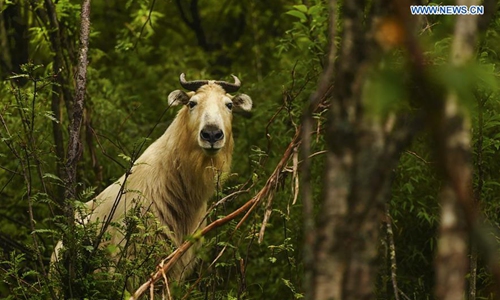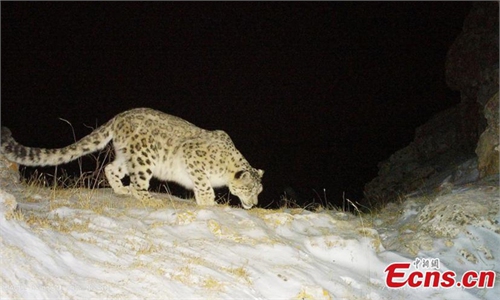ARTS / CULTURE & LEISURE
China's environmental efforts paying off as endangered wildlife begin to make comeback

Takins walk on the edge of a cliff in the Qinling Mountains, northwest China's Shaanxi Province, June 27, 2019. The Qinling Mountains, a natural boundary between the country's north and south, are home to a huge variety of plants and wild animals such as giant pandas, golden monkeys, crested ibis and takins. Photo:Xinhua
More and more endangered wild animals including snow leopards, takins and Tibetan antelopes are reappearing around China, reflecting the country's environmental protection and wildlife conservation efforts.
Herds of Tibetan antelope, a first class national protected animal, were spotted foraging near the Qilian Mountains in Northwest China's Gansu Province recently, according to a report from the Xinhua News Agency.
As the environment along the mountain range has improved, other wild animals have been making a comeback in the region, such as golden eagles and Tibetan antelopes.
A camera set up by a research team in another national nature reserve in Gansu managed to capture footage of a snow leopard, a kind of large cat listed as vulnerable on the IUCN Red List because the global population is estimated to be less than 10,000, according to a report from Chinese news site The Paper.
"The appearance and increased population of these rare animals can be considered as a good sign that the environment in China is improving," Shi Kun, director of the Wildlife Research Institute of Beijing Forestry University, told the Global Times on Thursday.
Shi said that this improvement is the result of long-term efforts made since 2000.
"China has implemented many protective measures such as returning farmland to forests and establishing nature reserves over the past 20 years, and now the positive results are beginning to show."
Other rare animals have also been making appearances for the first time in places outside their usual habitat.
The Beijing News reported that a takin was seen drinking water from a river in Shiyan, Central China's Hubei Province on Saturday. This is the first time that this first class national protected animal has been seen in the city. Largely due to overhunting and the destruction of their natural habitat, takin is considered endangered and only a few thousands remain in China.
Besides in Hubei, takins were also spotted in a national forest park in Northwest China's Shaanxi Province, where a wild giant panda was also spotted for the first time ever. The national forest park is near the Qinling Mountains and its deputy director attributed the appearance of these animals to the improved environment of the mountains, he said in a video posted by Pear Video on Sina Weibo.
In addition to improving the environment, other measures to protect wild animals have also been introduced.
The latest edition of the Chinese Pharmacopoeia, an official compendium of the Traditional Chinese and Western medicines, no longer includes pangolins, the only mammal with scales, which means it will no longer be used in the traditional Chinese medicine (TCM).
Chinese netizens supported the move and called for Chinese businesses to adopt a "no sell, no harm" policy. "Don't let commercial use wipe out a species," was another rallying cry.
Over 12 cities and provinces in China such as South China's Guangdong Province and Central China's Hunan Province have launched bans on consuming and eating wild animals, the China News Service reported in April.
Although achievements have been made, that doesn't mean progress can be stopped.
Shi noted that the Chinese government should implement further measures and the public should also do more to protect wild animals.
"The Law of China on the Protection of Wildlife, which took effect in 1989, needs to be revised according to the present situation, protective measures in nature reserves need to be upgraded and more scientifists should be trained to work in nature reserves," he suggested.


